Detailed Analysis of Health Promotion Programs at Algester Lodge, USC
VerifiedAdded on 2023/06/04
|5
|1829
|372
Report
AI Summary
This report provides an analysis of health promotion programs, specifically focusing on the 'Changing Settings' component of the health promotion setting analysis framework, using Algester Lodge Nursing Home as a case study. The analysis covers various aspects, including the context of the health promotion setting, its history, and the roles of health promotion practitioners and stakeholders. It delves into the capacities required for continuous improvement within the setting, outlining key components such as innovation, stakeholder engagement, and evaluation. The report also examines the strategies employed, including resident responsibilities and facility policies related to alcohol, pets, smoking, and vehicles. Furthermore, it addresses engagement issues, project governance, and the evaluation of health promotion strategies, including the definition of success and the identification of unintended consequences. The report references various articles and frameworks to support its analysis, offering a comprehensive understanding of health promotion practices in an aged care setting.
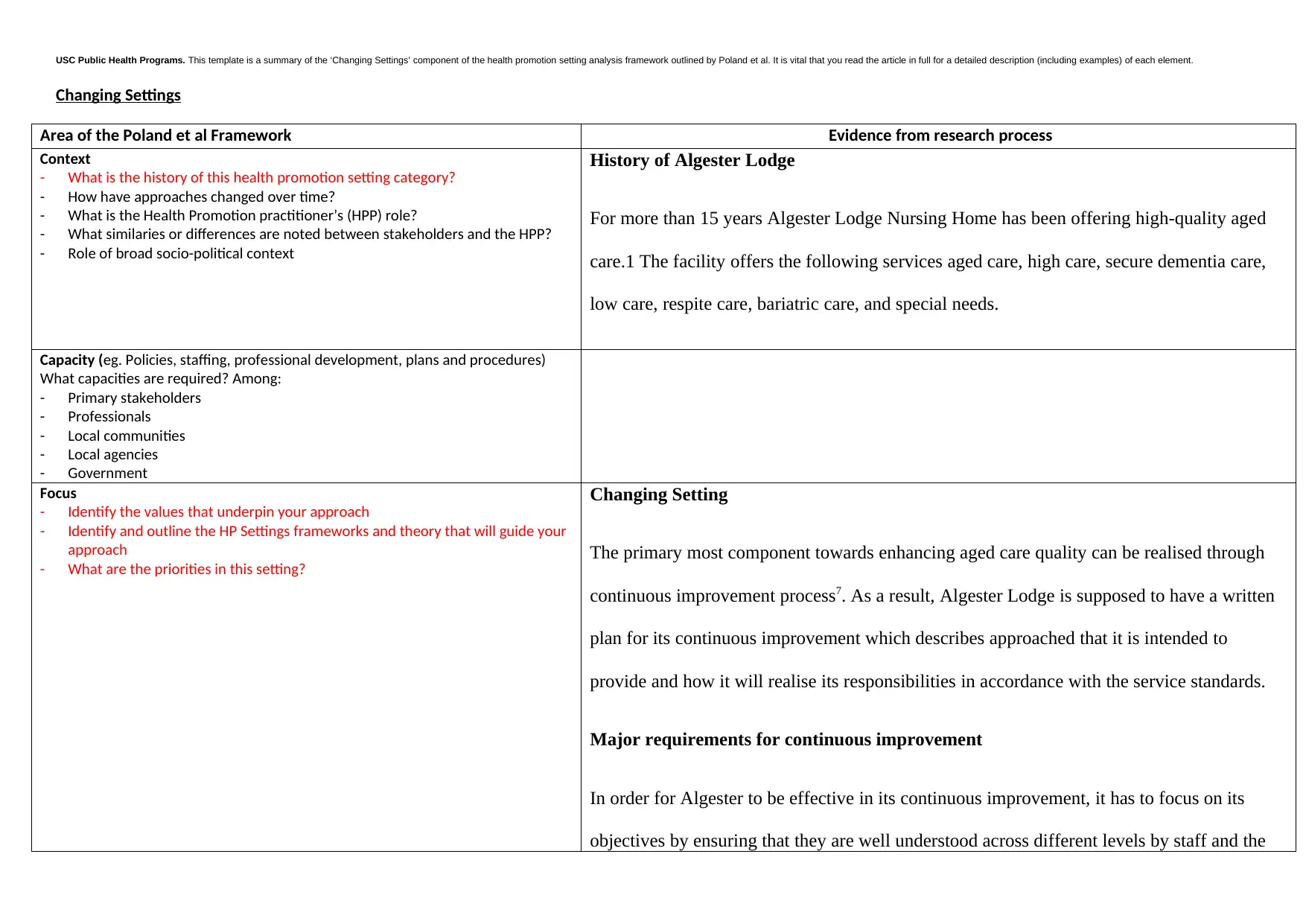
USC Public Health Programs. This template is a summary of the ‘Changing Settings’ component of the health promotion setting analysis framework outlined by Poland et al. It is vital that you read the article in full for a detailed description (including examples) of each element.
Changing Settings
Area of the Poland et al Framework Evidence from research process
Context
- What is the history of this health promotion setting category?
- How have approaches changed over time?
- What is the Health Promotion practitioner’s (HPP) role?
- What similaries or differences are noted between stakeholders and the HPP?
- Role of broad socio-political context
History of Algester Lodge
For more than 15 years Algester Lodge Nursing Home has been offering high-quality aged
care.1 The facility offers the following services aged care, high care, secure dementia care,
low care, respite care, bariatric care, and special needs.
Capacity (eg. Policies, staffing, professional development, plans and procedures)
What capacities are required? Among:
- Primary stakeholders
- Professionals
- Local communities
- Local agencies
- Government
Focus
- Identify the values that underpin your approach
- Identify and outline the HP Settings frameworks and theory that will guide your
approach
- What are the priorities in this setting?
Changing Setting
The primary most component towards enhancing aged care quality can be realised through
continuous improvement process7. As a result, Algester Lodge is supposed to have a written
plan for its continuous improvement which describes approached that it is intended to
provide and how it will realise its responsibilities in accordance with the service standards.
Major requirements for continuous improvement
In order for Algester to be effective in its continuous improvement, it has to focus on its
objectives by ensuring that they are well understood across different levels by staff and the
Changing Settings
Area of the Poland et al Framework Evidence from research process
Context
- What is the history of this health promotion setting category?
- How have approaches changed over time?
- What is the Health Promotion practitioner’s (HPP) role?
- What similaries or differences are noted between stakeholders and the HPP?
- Role of broad socio-political context
History of Algester Lodge
For more than 15 years Algester Lodge Nursing Home has been offering high-quality aged
care.1 The facility offers the following services aged care, high care, secure dementia care,
low care, respite care, bariatric care, and special needs.
Capacity (eg. Policies, staffing, professional development, plans and procedures)
What capacities are required? Among:
- Primary stakeholders
- Professionals
- Local communities
- Local agencies
- Government
Focus
- Identify the values that underpin your approach
- Identify and outline the HP Settings frameworks and theory that will guide your
approach
- What are the priorities in this setting?
Changing Setting
The primary most component towards enhancing aged care quality can be realised through
continuous improvement process7. As a result, Algester Lodge is supposed to have a written
plan for its continuous improvement which describes approached that it is intended to
provide and how it will realise its responsibilities in accordance with the service standards.
Major requirements for continuous improvement
In order for Algester to be effective in its continuous improvement, it has to focus on its
objectives by ensuring that they are well understood across different levels by staff and the
Paraphrase This Document
Need a fresh take? Get an instant paraphrase of this document with our AI Paraphraser
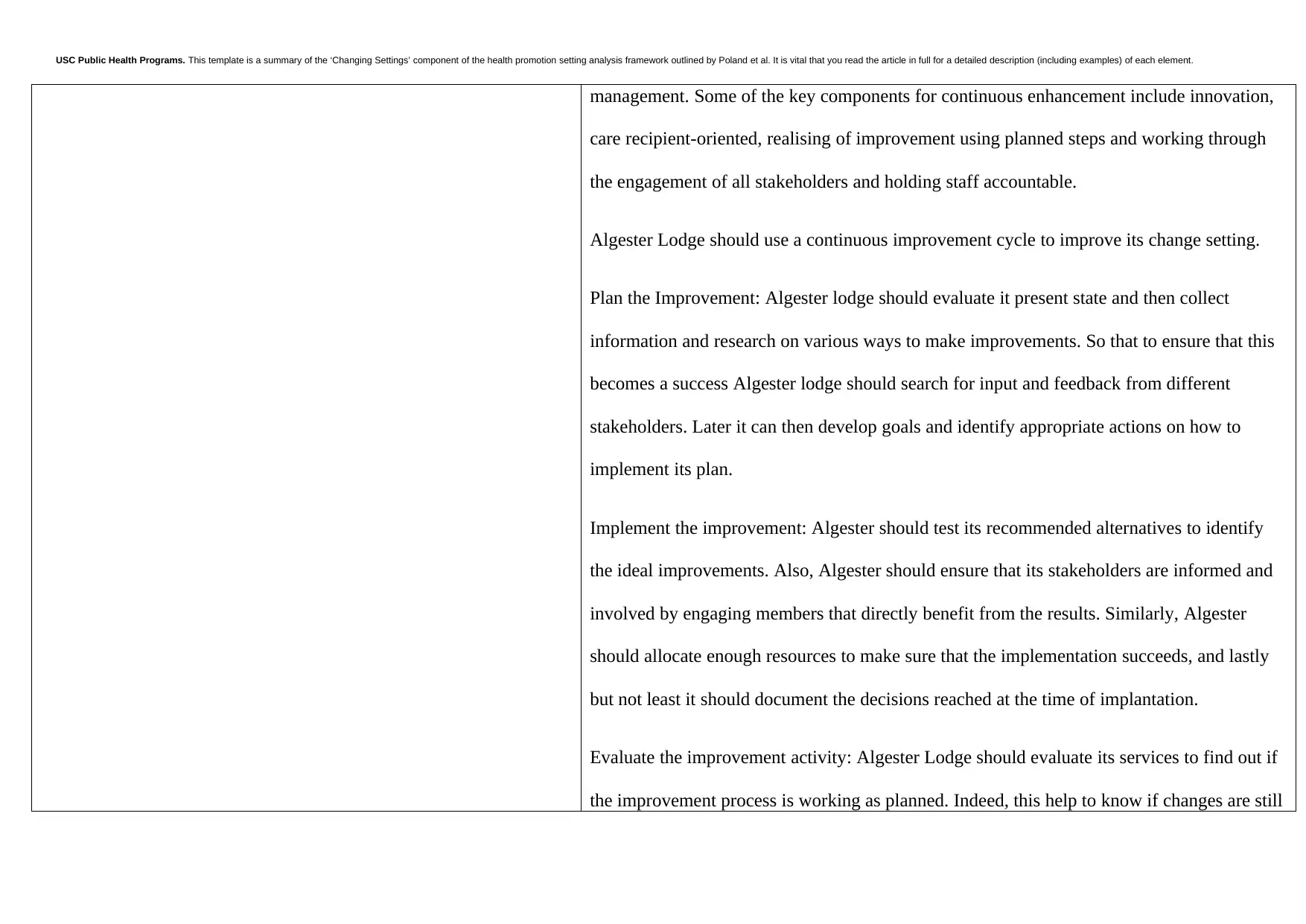
USC Public Health Programs. This template is a summary of the ‘Changing Settings’ component of the health promotion setting analysis framework outlined by Poland et al. It is vital that you read the article in full for a detailed description (including examples) of each element.
management. Some of the key components for continuous enhancement include innovation,
care recipient-oriented, realising of improvement using planned steps and working through
the engagement of all stakeholders and holding staff accountable.
Algester Lodge should use a continuous improvement cycle to improve its change setting.
Plan the Improvement: Algester lodge should evaluate it present state and then collect
information and research on various ways to make improvements. So that to ensure that this
becomes a success Algester lodge should search for input and feedback from different
stakeholders. Later it can then develop goals and identify appropriate actions on how to
implement its plan.
Implement the improvement: Algester should test its recommended alternatives to identify
the ideal improvements. Also, Algester should ensure that its stakeholders are informed and
involved by engaging members that directly benefit from the results. Similarly, Algester
should allocate enough resources to make sure that the implementation succeeds, and lastly
but not least it should document the decisions reached at the time of implantation.
Evaluate the improvement activity: Algester Lodge should evaluate its services to find out if
the improvement process is working as planned. Indeed, this help to know if changes are still
management. Some of the key components for continuous enhancement include innovation,
care recipient-oriented, realising of improvement using planned steps and working through
the engagement of all stakeholders and holding staff accountable.
Algester Lodge should use a continuous improvement cycle to improve its change setting.
Plan the Improvement: Algester lodge should evaluate it present state and then collect
information and research on various ways to make improvements. So that to ensure that this
becomes a success Algester lodge should search for input and feedback from different
stakeholders. Later it can then develop goals and identify appropriate actions on how to
implement its plan.
Implement the improvement: Algester should test its recommended alternatives to identify
the ideal improvements. Also, Algester should ensure that its stakeholders are informed and
involved by engaging members that directly benefit from the results. Similarly, Algester
should allocate enough resources to make sure that the implementation succeeds, and lastly
but not least it should document the decisions reached at the time of implantation.
Evaluate the improvement activity: Algester Lodge should evaluate its services to find out if
the improvement process is working as planned. Indeed, this help to know if changes are still
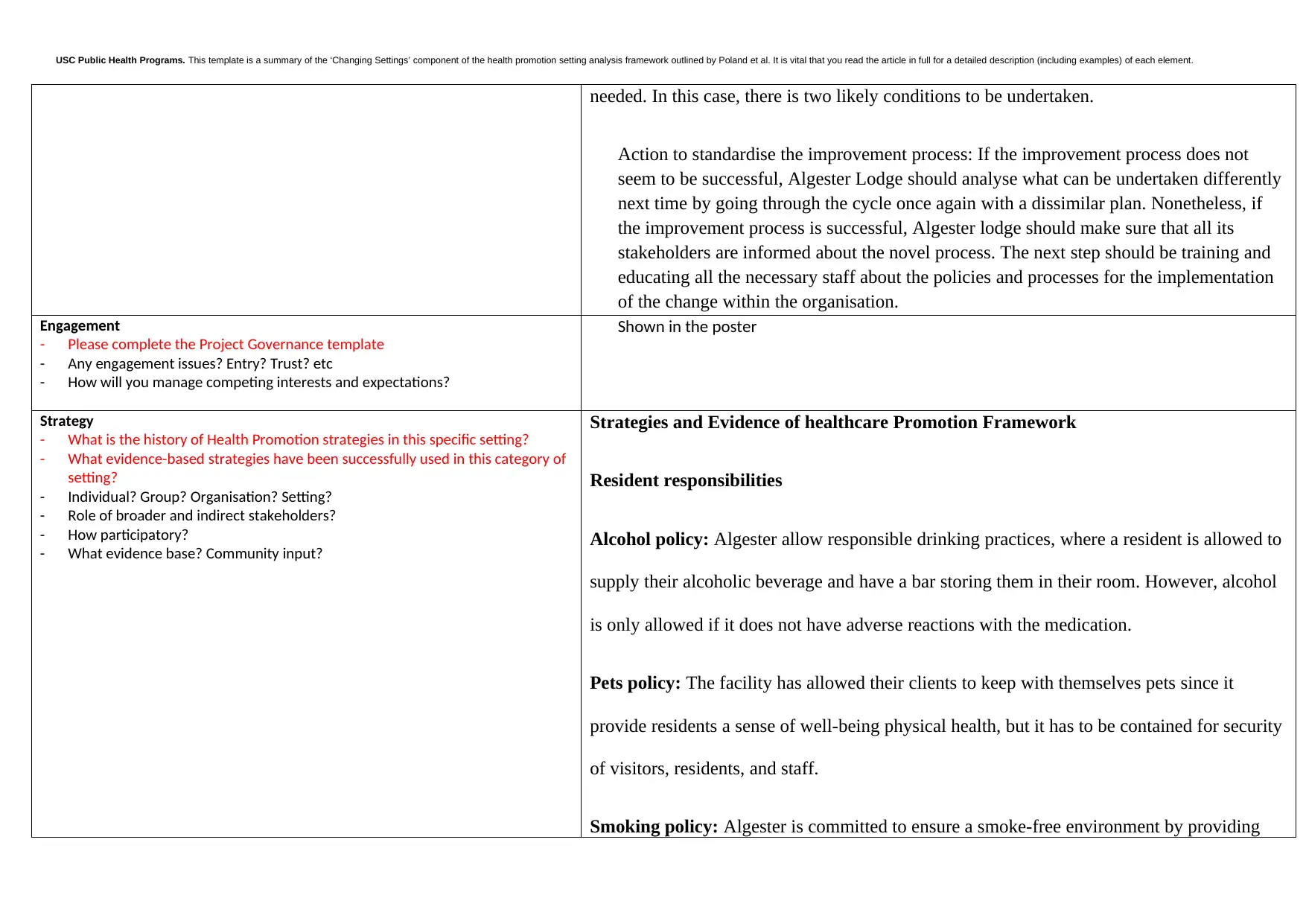
USC Public Health Programs. This template is a summary of the ‘Changing Settings’ component of the health promotion setting analysis framework outlined by Poland et al. It is vital that you read the article in full for a detailed description (including examples) of each element.
needed. In this case, there is two likely conditions to be undertaken.
Action to standardise the improvement process: If the improvement process does not
seem to be successful, Algester Lodge should analyse what can be undertaken differently
next time by going through the cycle once again with a dissimilar plan. Nonetheless, if
the improvement process is successful, Algester lodge should make sure that all its
stakeholders are informed about the novel process. The next step should be training and
educating all the necessary staff about the policies and processes for the implementation
of the change within the organisation.
Engagement
- Please complete the Project Governance template
- Any engagement issues? Entry? Trust? etc
- How will you manage competing interests and expectations?
Shown in the poster
Strategy
- What is the history of Health Promotion strategies in this specific setting?
- What evidence-based strategies have been successfully used in this category of
setting?
- Individual? Group? Organisation? Setting?
- Role of broader and indirect stakeholders?
- How participatory?
- What evidence base? Community input?
Strategies and Evidence of healthcare Promotion Framework
Resident responsibilities
Alcohol policy: Algester allow responsible drinking practices, where a resident is allowed to
supply their alcoholic beverage and have a bar storing them in their room. However, alcohol
is only allowed if it does not have adverse reactions with the medication.
Pets policy: The facility has allowed their clients to keep with themselves pets since it
provide residents a sense of well-being physical health, but it has to be contained for security
of visitors, residents, and staff.
Smoking policy: Algester is committed to ensure a smoke-free environment by providing
needed. In this case, there is two likely conditions to be undertaken.
Action to standardise the improvement process: If the improvement process does not
seem to be successful, Algester Lodge should analyse what can be undertaken differently
next time by going through the cycle once again with a dissimilar plan. Nonetheless, if
the improvement process is successful, Algester lodge should make sure that all its
stakeholders are informed about the novel process. The next step should be training and
educating all the necessary staff about the policies and processes for the implementation
of the change within the organisation.
Engagement
- Please complete the Project Governance template
- Any engagement issues? Entry? Trust? etc
- How will you manage competing interests and expectations?
Shown in the poster
Strategy
- What is the history of Health Promotion strategies in this specific setting?
- What evidence-based strategies have been successfully used in this category of
setting?
- Individual? Group? Organisation? Setting?
- Role of broader and indirect stakeholders?
- How participatory?
- What evidence base? Community input?
Strategies and Evidence of healthcare Promotion Framework
Resident responsibilities
Alcohol policy: Algester allow responsible drinking practices, where a resident is allowed to
supply their alcoholic beverage and have a bar storing them in their room. However, alcohol
is only allowed if it does not have adverse reactions with the medication.
Pets policy: The facility has allowed their clients to keep with themselves pets since it
provide residents a sense of well-being physical health, but it has to be contained for security
of visitors, residents, and staff.
Smoking policy: Algester is committed to ensure a smoke-free environment by providing
⊘ This is a preview!⊘
Do you want full access?
Subscribe today to unlock all pages.

Trusted by 1+ million students worldwide
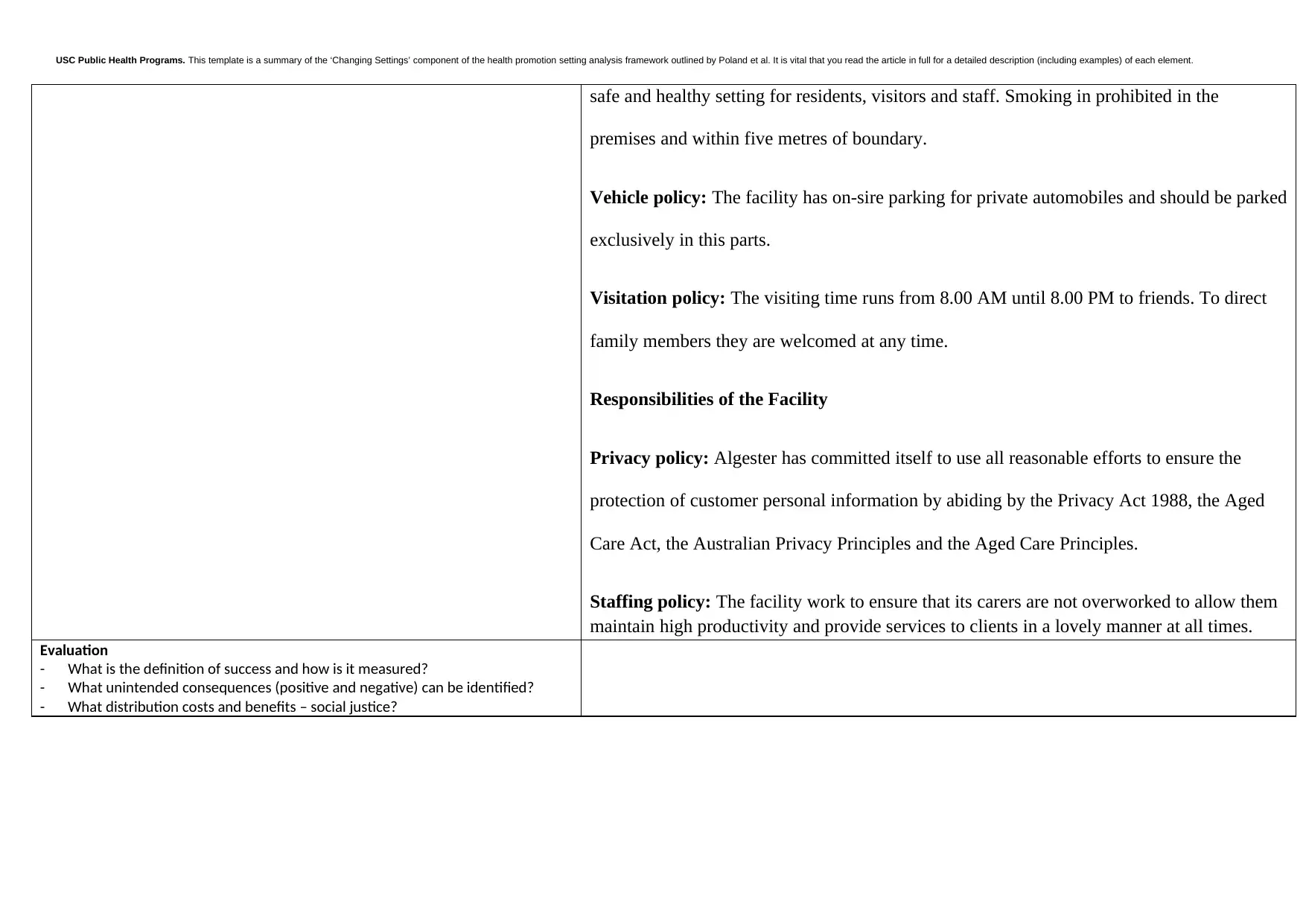
USC Public Health Programs. This template is a summary of the ‘Changing Settings’ component of the health promotion setting analysis framework outlined by Poland et al. It is vital that you read the article in full for a detailed description (including examples) of each element.
safe and healthy setting for residents, visitors and staff. Smoking in prohibited in the
premises and within five metres of boundary.
Vehicle policy: The facility has on-sire parking for private automobiles and should be parked
exclusively in this parts.
Visitation policy: The visiting time runs from 8.00 AM until 8.00 PM to friends. To direct
family members they are welcomed at any time.
Responsibilities of the Facility
Privacy policy: Algester has committed itself to use all reasonable efforts to ensure the
protection of customer personal information by abiding by the Privacy Act 1988, the Aged
Care Act, the Australian Privacy Principles and the Aged Care Principles.
Staffing policy: The facility work to ensure that its carers are not overworked to allow them
maintain high productivity and provide services to clients in a lovely manner at all times.
Evaluation
- What is the definition of success and how is it measured?
- What unintended consequences (positive and negative) can be identified?
- What distribution costs and benefits – social justice?
safe and healthy setting for residents, visitors and staff. Smoking in prohibited in the
premises and within five metres of boundary.
Vehicle policy: The facility has on-sire parking for private automobiles and should be parked
exclusively in this parts.
Visitation policy: The visiting time runs from 8.00 AM until 8.00 PM to friends. To direct
family members they are welcomed at any time.
Responsibilities of the Facility
Privacy policy: Algester has committed itself to use all reasonable efforts to ensure the
protection of customer personal information by abiding by the Privacy Act 1988, the Aged
Care Act, the Australian Privacy Principles and the Aged Care Principles.
Staffing policy: The facility work to ensure that its carers are not overworked to allow them
maintain high productivity and provide services to clients in a lovely manner at all times.
Evaluation
- What is the definition of success and how is it measured?
- What unintended consequences (positive and negative) can be identified?
- What distribution costs and benefits – social justice?
Paraphrase This Document
Need a fresh take? Get an instant paraphrase of this document with our AI Paraphraser
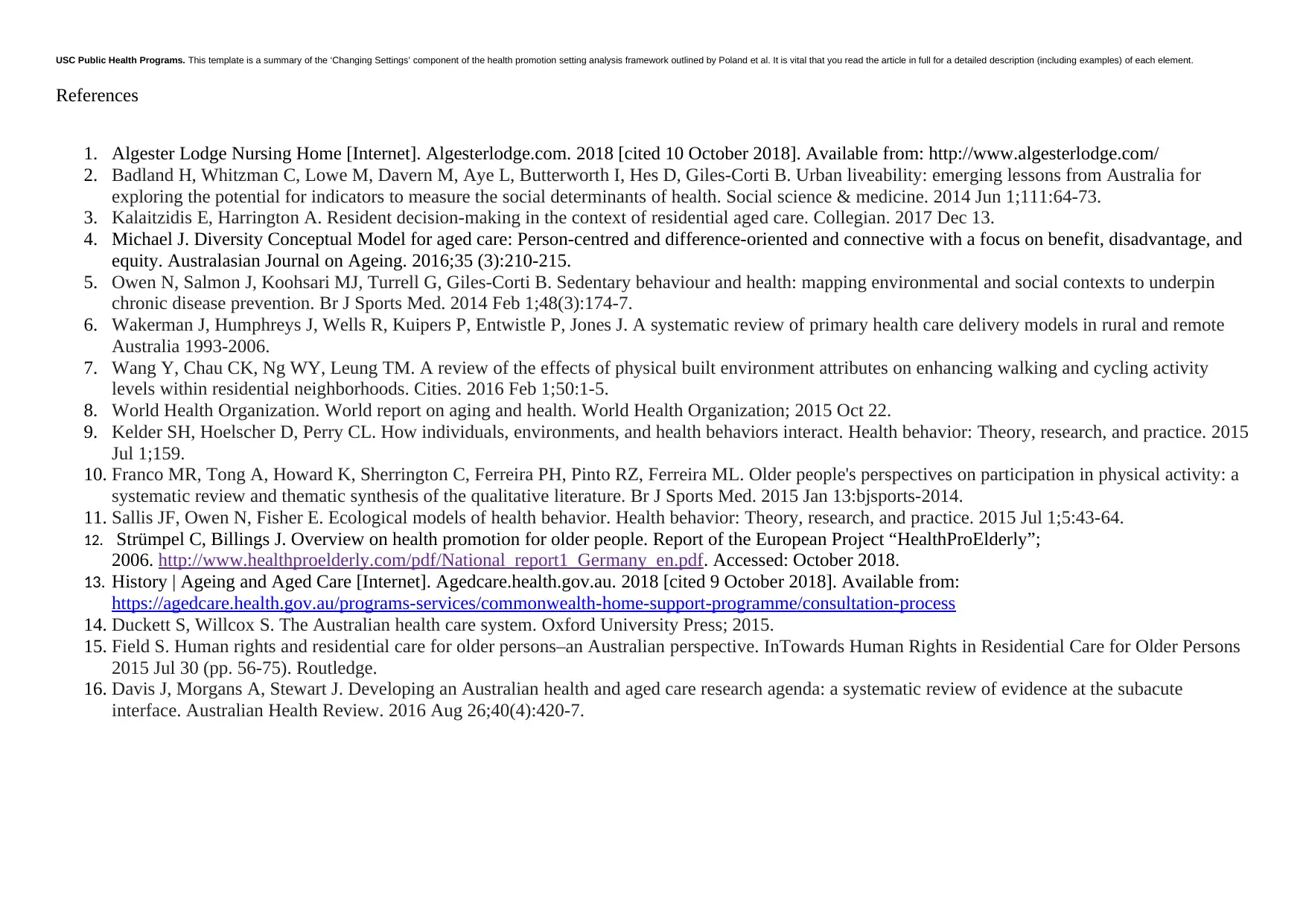
USC Public Health Programs. This template is a summary of the ‘Changing Settings’ component of the health promotion setting analysis framework outlined by Poland et al. It is vital that you read the article in full for a detailed description (including examples) of each element.
References
1. Algester Lodge Nursing Home [Internet]. Algesterlodge.com. 2018 [cited 10 October 2018]. Available from: http://www.algesterlodge.com/
2. Badland H, Whitzman C, Lowe M, Davern M, Aye L, Butterworth I, Hes D, Giles-Corti B. Urban liveability: emerging lessons from Australia for
exploring the potential for indicators to measure the social determinants of health. Social science & medicine. 2014 Jun 1;111:64-73.
3. Kalaitzidis E, Harrington A. Resident decision-making in the context of residential aged care. Collegian. 2017 Dec 13.
4. Michael J. Diversity Conceptual Model for aged care: Person-centred and difference-oriented and connective with a focus on benefit, disadvantage, and
equity. Australasian Journal on Ageing. 2016;35 (3):210-215.
5. Owen N, Salmon J, Koohsari MJ, Turrell G, Giles-Corti B. Sedentary behaviour and health: mapping environmental and social contexts to underpin
chronic disease prevention. Br J Sports Med. 2014 Feb 1;48(3):174-7.
6. Wakerman J, Humphreys J, Wells R, Kuipers P, Entwistle P, Jones J. A systematic review of primary health care delivery models in rural and remote
Australia 1993-2006.
7. Wang Y, Chau CK, Ng WY, Leung TM. A review of the effects of physical built environment attributes on enhancing walking and cycling activity
levels within residential neighborhoods. Cities. 2016 Feb 1;50:1-5.
8. World Health Organization. World report on aging and health. World Health Organization; 2015 Oct 22.
9. Kelder SH, Hoelscher D, Perry CL. How individuals, environments, and health behaviors interact. Health behavior: Theory, research, and practice. 2015
Jul 1;159.
10. Franco MR, Tong A, Howard K, Sherrington C, Ferreira PH, Pinto RZ, Ferreira ML. Older people's perspectives on participation in physical activity: a
systematic review and thematic synthesis of the qualitative literature. Br J Sports Med. 2015 Jan 13:bjsports-2014.
11. Sallis JF, Owen N, Fisher E. Ecological models of health behavior. Health behavior: Theory, research, and practice. 2015 Jul 1;5:43-64.
12. Strümpel C, Billings J. Overview on health promotion for older people. Report of the European Project “HealthProElderly”;
2006. http://www.healthproelderly.com/pdf/National_report1_Germany_en.pdf. Accessed: October 2018.
13. History | Ageing and Aged Care [Internet]. Agedcare.health.gov.au. 2018 [cited 9 October 2018]. Available from:
https://agedcare.health.gov.au/programs-services/commonwealth-home-support-programme/consultation-process
14. Duckett S, Willcox S. The Australian health care system. Oxford University Press; 2015.
15. Field S. Human rights and residential care for older persons–an Australian perspective. InTowards Human Rights in Residential Care for Older Persons
2015 Jul 30 (pp. 56-75). Routledge.
16. Davis J, Morgans A, Stewart J. Developing an Australian health and aged care research agenda: a systematic review of evidence at the subacute
interface. Australian Health Review. 2016 Aug 26;40(4):420-7.
References
1. Algester Lodge Nursing Home [Internet]. Algesterlodge.com. 2018 [cited 10 October 2018]. Available from: http://www.algesterlodge.com/
2. Badland H, Whitzman C, Lowe M, Davern M, Aye L, Butterworth I, Hes D, Giles-Corti B. Urban liveability: emerging lessons from Australia for
exploring the potential for indicators to measure the social determinants of health. Social science & medicine. 2014 Jun 1;111:64-73.
3. Kalaitzidis E, Harrington A. Resident decision-making in the context of residential aged care. Collegian. 2017 Dec 13.
4. Michael J. Diversity Conceptual Model for aged care: Person-centred and difference-oriented and connective with a focus on benefit, disadvantage, and
equity. Australasian Journal on Ageing. 2016;35 (3):210-215.
5. Owen N, Salmon J, Koohsari MJ, Turrell G, Giles-Corti B. Sedentary behaviour and health: mapping environmental and social contexts to underpin
chronic disease prevention. Br J Sports Med. 2014 Feb 1;48(3):174-7.
6. Wakerman J, Humphreys J, Wells R, Kuipers P, Entwistle P, Jones J. A systematic review of primary health care delivery models in rural and remote
Australia 1993-2006.
7. Wang Y, Chau CK, Ng WY, Leung TM. A review of the effects of physical built environment attributes on enhancing walking and cycling activity
levels within residential neighborhoods. Cities. 2016 Feb 1;50:1-5.
8. World Health Organization. World report on aging and health. World Health Organization; 2015 Oct 22.
9. Kelder SH, Hoelscher D, Perry CL. How individuals, environments, and health behaviors interact. Health behavior: Theory, research, and practice. 2015
Jul 1;159.
10. Franco MR, Tong A, Howard K, Sherrington C, Ferreira PH, Pinto RZ, Ferreira ML. Older people's perspectives on participation in physical activity: a
systematic review and thematic synthesis of the qualitative literature. Br J Sports Med. 2015 Jan 13:bjsports-2014.
11. Sallis JF, Owen N, Fisher E. Ecological models of health behavior. Health behavior: Theory, research, and practice. 2015 Jul 1;5:43-64.
12. Strümpel C, Billings J. Overview on health promotion for older people. Report of the European Project “HealthProElderly”;
2006. http://www.healthproelderly.com/pdf/National_report1_Germany_en.pdf. Accessed: October 2018.
13. History | Ageing and Aged Care [Internet]. Agedcare.health.gov.au. 2018 [cited 9 October 2018]. Available from:
https://agedcare.health.gov.au/programs-services/commonwealth-home-support-programme/consultation-process
14. Duckett S, Willcox S. The Australian health care system. Oxford University Press; 2015.
15. Field S. Human rights and residential care for older persons–an Australian perspective. InTowards Human Rights in Residential Care for Older Persons
2015 Jul 30 (pp. 56-75). Routledge.
16. Davis J, Morgans A, Stewart J. Developing an Australian health and aged care research agenda: a systematic review of evidence at the subacute
interface. Australian Health Review. 2016 Aug 26;40(4):420-7.
1 out of 5
Related Documents
Your All-in-One AI-Powered Toolkit for Academic Success.
+13062052269
info@desklib.com
Available 24*7 on WhatsApp / Email
![[object Object]](/_next/static/media/star-bottom.7253800d.svg)
Unlock your academic potential
Copyright © 2020–2025 A2Z Services. All Rights Reserved. Developed and managed by ZUCOL.





